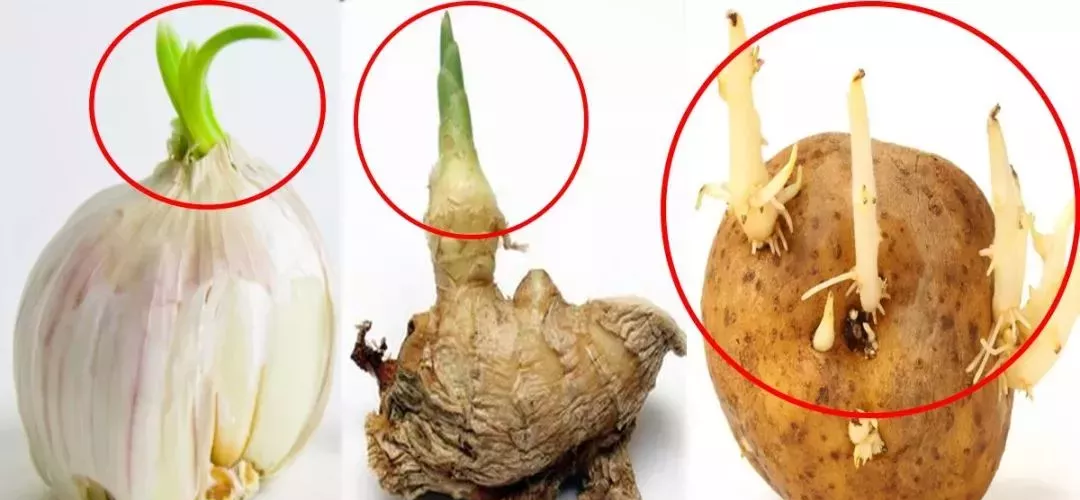In daily life, people often encounter food that sprouts after a period of time, which brings confusion: good food sprouts, can it still be eaten?

The pictures in the text come from the Internet, if there is a copyright problem, please contact the author to delete!
In fact, whether food can be eaten or not depends not on its state, but on whether it contains toxic substances.
1. Sprouted potatoes, highly toxic, please throw away!
When it comes to "sprouted food is poisonous", potatoes are definitely on the list. In order to resist the invasion of pests, potatoes can produce some toxic substances to protect themselves, the most famous of which is "dragon flower alkali". The dragon root produced by potatoes is mainly found in the stems and leaves, and the part we often eat is its tubers.
The content of longqualin in the normal state is very low, but once it begins to sprout and turn green, it will be produced in large quantities, exceeding the range of safe consumption. So eating sprouted potatoes can easily lead to food poisoning. So to be on the safe side, it's best to throw it away.
2. Sprouted sweet potatoes, not poisonous but best not to eat!
Sweet potatoes and potatoes are two completely different types of plants. Potatoes are in the solanaceae family, sweet potatoes are in the family Spinosa, and one is a tuber and the other is a root. For sweet potatoes, germination itself does not produce any harmful substances, but we do not recommend that you eat sprouted sweet potatoes.
Under the environmental conditions suitable for germination, it is also suitable for sweet potato mildew. Molds produce some toxins during growth and reproduction. Generally sweet potato germination will be accompanied by mildew, so be sure to check carefully, once found abnormal, do not eat again.
3. Sprouted peanuts may produce aflatoxin!
When the flowers grow peanut buds, it is recommended that everyone do not eat them again. Because the peanut shell is destroyed, it is easily contaminated with mold, and aflatoxin with strong carcinogenic effect is generated.
On the one hand, the humidity, temperature and other conditions suitable for germination are very suitable for the growth of mold; on the other hand, if the peanut is not very good, then it is likely that there is already mold. So the peanuts that sprout at home are likely to be a comfortable hotbed for aflatoxin production. Therefore, it is safer to throw it away for the sake of safety.
4. Sprouted garlic, edible.
Garlic that is usually bought back is easy to sprout long leaves in the right temperature environment. Such "secondary development" will indeed consume part of the nutritional value of garlic itself, making garlic cloves shrink, dry, and taste reduced, but it will not produce toxic substances and can be eaten. However, garlic changes color and moldy rot at the same time as germination, and it cannot be eaten, remember!
5. Sprouted ginger, edible.
Most of the ginger bought home actually has buds, but some buds are inconspicuous and some buds are removed. If you use a knife to cut the sprouted ginger, you will find that its flesh inside is dry and the fibers are rough. After germination, the nutritional value of ginger is reduced, but its main ingredients are not destroyed and can be eaten.
Speaking of which, remind everyone: if the ginger has rotted, don't eat it again. Rotten ginger contains a substance called safrole, which may cause hepatocyte degeneration and necrosis, which can induce various liver diseases and should not be consumed!
6. Sprouted taro, edible.
Like potatoes, taro will sprout if left for a long time. Although the nutritional composition of taro is similar to that of potatoes, sprouted taro is non-toxic and edible.
7. Sprouted brown rice, doubling the nutrients!
When brown rice sprouts, a large number of enzyme sources are activated, and a variety of hydrolases are newly generated, such as amylase, hemicellulase, protease, oxidoradose, etc., so that the energy and nutrients inside brown rice change significantly, some large molecules become small molecules, and nutrients are easier to digest and absorb.
Some current studies have shown that sprouted brown rice is rich in B vitamins, vitamin A, vitamin E, niacin, pantothenic acid and so on. Moreover, minerals such as calcium and magnesium in brown rice are mostly combined with phytic acid, and it is difficult to be absorbed by the body when eaten. However, during the germination process, phytase is activated, phytic acid is decomposed, and mineral elements are released, which is easily digested and absorbed by the human body. However, the germination process and germination degree of brown rice need to be strictly controlled by hand, and it should be dried immediately after reaching the expected level, otherwise it is also easy to produce mold and toxins.
Which of the sprouted foods can be eaten and which cannot be eaten, must be clear!